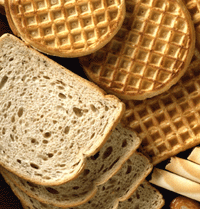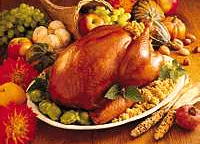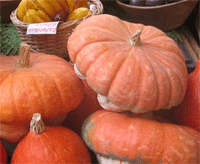Fall 2005: To Your Health
In this Issue:
- MyPyramid Quick Tips
- Adding Whole Grains for a Wholesome Diet
- Thanksgiving Turkey Basics
- Enjoy a Lower-Fat Thanksgiving This Year
- Feature Food of the Month: Berries
- Healthy Recipe: Apple Cranberry Crisp
MyPyramid Quick Tips
 According to the Surgeon General, an estimated 300,000 deaths a year can be attributed to obesity. In addition, individuals who are obese have a 50-100% increased risk of premature death from all causes, compared to individuals with a healthy weight. The American government is trying to step up and help everyone achieve a healthy diet. The guidelines define a healthy diet as: “A diet that has an emphasis on fruits, vegetables, whole grains and fat-free or low fat milk products; includes lean meats, poultry, fish, beans, eggs and nuts and is low in saturated fats, trans fats, cholesterol, salt (sodium) and added sugars.”
According to the Surgeon General, an estimated 300,000 deaths a year can be attributed to obesity. In addition, individuals who are obese have a 50-100% increased risk of premature death from all causes, compared to individuals with a healthy weight. The American government is trying to step up and help everyone achieve a healthy diet. The guidelines define a healthy diet as: “A diet that has an emphasis on fruits, vegetables, whole grains and fat-free or low fat milk products; includes lean meats, poultry, fish, beans, eggs and nuts and is low in saturated fats, trans fats, cholesterol, salt (sodium) and added sugars.”
In April 2005, the USDA released the new and improved version of the Food Guide Pyramid entitled, MyPyramid: Steps to a Healthier You. The new version is now designed to fit each person’s individual needs, not only focusing on the food aspect, but also emphasizing the importance of a daily exercise regiment. Here are a few quick tips to understanding the new pyramid to help you use it while planning your daily menus.
- Pick a variety of foods from each of the food groups. Be adventurous and try new foods that you might never have thought of such as soybeans or pomegranates.
- Use moderation when picking foods with higher saturated fat contents within each of the categories. Choose low fat or fat free cheese.
- Drink at least three cups a day of fat free or low fat milk. It’s a great source of calcium, vitamins A, D, B12, and zinc.
- Choose whole fruits and vegetables. These will give you vitamins and minerals and fiber. And remember, frozen vegetables are great if you are on the go!
- Fit in at least thirty minutes of moderate exercise most days of the week. You can break this up into 2 fifteen-minute intervals or even 3 ten-minute intervals. It doesn’t need to take over your schedule, it is just important to remember to do it and you will be amazed when you see your health improve!
For help on incorporating the MyPyramid Quick Tips into your daily menus, check out our Menu Development services.
Adding Whole Grains for a Wholesome Diet
 According to the 2005 Dietary Guidelines for Americans, we should all be eating at least 3 one ounce servings of whole grains per day. What makes these whole grain foods so much more beneficial to the body is that they provide the body with phytochemicals that offer protective and disease preventative qualities. They also offer other vitamins and minerals such as the B vitamins, vitamin E, iron, zinc, calcium, selenium and magnesium that have been found to help in preventing a variety of diseases.
According to the 2005 Dietary Guidelines for Americans, we should all be eating at least 3 one ounce servings of whole grains per day. What makes these whole grain foods so much more beneficial to the body is that they provide the body with phytochemicals that offer protective and disease preventative qualities. They also offer other vitamins and minerals such as the B vitamins, vitamin E, iron, zinc, calcium, selenium and magnesium that have been found to help in preventing a variety of diseases.
There have been 2 recent studies published showing the benefits of incorporating fiber and whole grains into the diet. The first study looked at the effects of fiber and vitamin supplements on cholesterol in healthy individuals who have LDL levels of 130 mg/dl or greater. The individuals in the study group followed an 8 week intervention eating a National Education Program step 1 diet with the addition of a fiber, vitamin and mineral supplement compared to a group of individuals who received a placebo. It was found that the subjects that had at least 4.0 grams of soluble fiber and 0.5 grams of insoluble fiber improved their LDL levels by 10.3% more than the subjects that did not follow the diet.
A second study released by the Tufts University showed that people who consumed at least 4.6 grams of fiber a day had a 14% reduction in their risk for cardiovascular disease. For people who consumed 6.3 grams of fiber a day, the risk of cardiovascular disease decreased even more by 21%.
Sources of dietary fiber are whole wheat breads, cereals, oats, barley, rye, brown rice, whole wheat pasta and even popcorn.
References: Sprecher D.L. et al. Fiber-Multivitamin Combination Therapy: A Beneficial Influence on Low-Density Lipoprotein and Homocysteine. Journal of the American Dietetic Association, Feb 2003 v103 i2 pg1166-1170.
Tufts University Health & Nutrition Letter. On the Whole Grains-Heart Disease Link. July 2003 v21 i5 pg 2(1).
Thanksgiving Turkey Basics

SAFE DEFROSTING
Turkeys must be kept at a safe temperature during thawing. While frozen, a turkey is safe indefinitely. However, as soon as it begins to defrost, any bacteria that may have been present before freezing can begin to grow again.
A package of frozen meat or poultry left thawing on the counter more than 2 hours is not at a safe temperature. Even though the center of the package may still be frozen, the outer layer of the food is in the “danger zone” between 40 and 140 degrees Fahrenheit – at a temperature when food borne bacteria multiply rapidly.
Immediately after returning home from the grocery store with your frozen turkey, store it in the freezer or refrigerator, if you want to begin defrosting it. There are three safe ways to defrost food: in the refrigerator, in cold water and in the microwave.
Refrigerator Thawing
When thawing a turkey in the refrigerator, there are several variables to take into account:
- Plan ahead. Allow approximately 24 hours for every 5 pounds in a refrigerator set at 40 degrees Fahrenheit.
- Some areas of a refrigerator may keep the food colder than others. A turkey placed in the coldest part will require longer defrosting time.
| Refrigerator Thawing Times (Whole Turkey) |
|
| 4 – 12 pounds | 1 to 3 days |
| 12 – 16 pounds | 3 to 4 days |
| 16 – 20 pounds | 4 to 5 days |
| 20 – 24 pounds | 5 to 6 days |
Cold Water Thawing
Allow 30 minutes per pound. Be sure the turkey is in a leak proof package or plastic bag. If the bag leaks, bacteria from the surrounding environment could be introduced into the food.
Immerse the turkey in cold tap water. Check the water frequently to be sure it stays cold. Change the water every 30 minutes, until the turkey is thawed.
| Cold Water Thawing Times (Whole Turkey) |
|
| 4 – 12 pounds | 2 to 6 hours |
| 12 – 16 pounds | 6 to 8 hours |
| 16 – 20 pounds | 8 to 10 hours |
| 20 – 24 pounds | 10 to 12 hours |
A turkey thawed by the cold water method should be cooked immediately. After cooking, meat from the turkey can be refrozen.
Microwave Thawing
Follow the microwave oven manufacturer’s instructions when defrosting a turkey. Plan to cook it immediately after thawing because some areas of the food may become warm and begin to cook during microwaving. Holding partially cooked food is not recommended because any bacteria present would not have been destroyed.
After cooking, meat from a turkey thawed in the microwave can be refrozen.
For more Thanksgiving Basics, please visit our Thanksgiving Special web section.
You’ll find information on:
Reference: Food Safety and Inspection Service, USDA.
Enjoy a Lower-Fat Thanksgiving This Year

This year enjoy a lighter Thanksgiving dinner that’s still packed with delicious flavor! For those of you who are weight-conscious or interested in eating heart-healthy, Thanksgiving does not have to be your downfall. Try the following tips to keep you on your path to good health.
- Go lighter on the appetizers. Most appetizers are high in fat and people tend to fill up on the appetizers even before the meal starts. Skip the mini franks in jackets, and chips and dip; opt instead for a veggie crudités platter with a salsa dip or a fruit platter. You will add beneficial fiber, vitamins and other nutrients instead of unwanted fat.
- Stick with a low-fat stuffing. Traditional stuffing recipes could pack as many as 200 calories and 10 grams of fat in only a ½ cup serving. And how many people only have a ½ cup! This year, try substituting chicken broth for the margarine/oil in your stuffing recipe. In addition, you can cut the calories by replacing ½ of the bread called for in the recipe with cooked vegetables. Here again, you are adding fiber and other nutrients while cutting down on the calories per serving. (A tasty low-fat stuffing recipe is available in the Recipes to Remember: Heart Healthy Can Be Delicious cookbook.)
- Start your meal with a salad. A green salad is a great way to start your meal. Use a variety of fresh greens and vegetables. Add raisins, sunflower seeds for added taste. Dress the salad with a light dressing or balsamic vinaigrette.
- Enjoy the turkey, but watch the gravy. Turkey is a great source of lean protein. Keep gravy to a minimum by putting some in the corner of your plate and dipping food into it rather than pouring it over the turkey and potatoes. Use fat-free gravy or be sure to skim the fat from the drippings to save on fat and calories. Beware of “self-basting” turkeys, which are injected with extra fat to keep the meat juicy. And lastly, avoid the turkey skin. The skin keeps the turkey moist while it is roasting, but it is loaded with fat. An ounce of roasted turkey skin has approximately 100 calories, mostly from fat (yes, in just one ounce)!
- Keep dessert light. Think about substituting some of the high-fat ingredients in your pumpkin pie recipe for lighter ones (for example use egg substitute instead of whole eggs and forgo the crust).
- Consider your portion sizes. You can still enjoy your traditional Thanksgiving recipes but just think smaller. Choose smaller portions of your favorite foods and eat in moderation!
Feature Food of the Month: Berries

Plump, juicy and sweet, berries promote mountains of health benefits!
Available fresh, frozen or dried, berries can be enjoyed year-round. Fold fresh blueberries into whole-wheat muffins, whirl frozen raspberries into frothy smoothies or mix dried cranberries with walnuts, cashews and pumpkin seeds for an energy-infused trail mix.
The health benefits of berries are quite remarkable. Overlooked for many years due to their low levels of vitamin c, berries found a nutritional niche with the discovery of antioxidants. Berries contain antioxidant compounds called anthocyanins, which reduce free radicals in the body. Free radicals have been shown to accelerate aging processes in the body. Research also shows that antioxidants may support normal levels of cholesterol and support healthy coronary artery function.
Pectin, a dietary fiber found in berries, may support the digestive system. Berries also supply iron, fiber, potassium and even small amounts of calcium and magnesium. Low in calories and high in flavor, berries are an outstanding, even super, food choice.
Blueberries contain more antioxidants than practically any other fruit or vegetable. Studies have shown that blueberries lower the risk of age-related disorders. Blueberries are also low in calories and high in fiber and antioxidants. Blueberries contain pectin, a soluble fiber that supports normal cholesterol levels.
Blackberries are a good source of pectin, folate and iron. Ellagic acid, an antioxidant found in blackberries, does not appear to deteriorate when cooked. So blackberries, baked in a golden crust or simmered into thick jams, retain this valuable phytochemical – enjoy!
Cranberries are a rich source of procyanidin, a phytochemical that supports cardiovascular and urinary tract health. Tangy and tart, cranberries shine when simmered into sauces and jellies or sautéed in wild rice pilaf.
Raspberries are packed with fiber, due to their tiny edible seeds. Rich in anthocyanin pigments, raspberries may also help rid the body of cell-damaging free radicals.
Strawberries boost your health with more vitamin C and fiber than any other berry. Sweet strawberries taste great all year long in fruit spreads, cool smoothies and fresh fruit salads.
Try a delicious, healthy strawberry smoothie! For more free recipes, click here.
Healthy Recipe: Apple Cranberry Crisp
Ingredients:
3 cups fresh apples, peeled and sliced
2 cups fresh cranberries
¾ cup Splenda™
2/3 cups all-purpose flour
¼ cup low fat margarine
½ cup Splenda™
2 tsp. cinnamon
Instructions:
Combine apples, cranberries, ¾ cup Splenda™ in an ungreased pan. In a separate bowl mix together flour, cinnamon, margarine, and ½ cup Splenda™. Sprinkle mixture over top of the apples and cranberries. Bake in a preheated 350 degree oven approximately 50-60 minutes or until bubbly and lightly browned.
Yield: 8 servings
Serving size: ½ cup
Exchange: 1 fruit, ½ starch, ½ fat
Nutrition Facts:
Calories = 144
Total Fat = 3 grams
Saturated Fat = 0.4 grams
Cholesterol = 0 milligrams
Protein = 1.3 grams
Carbohydrate = 32 grams
Sodium = 200 milligrams
Dietary Fiber = 3 grams
For more healthy recipes, click here.


Leave a Reply
Want to join the discussion?Feel free to contribute!